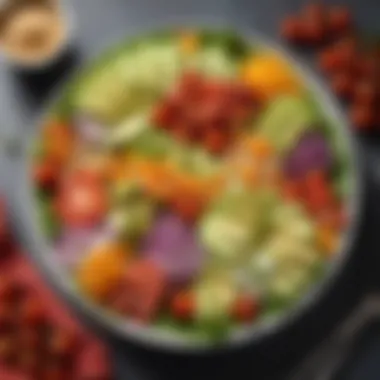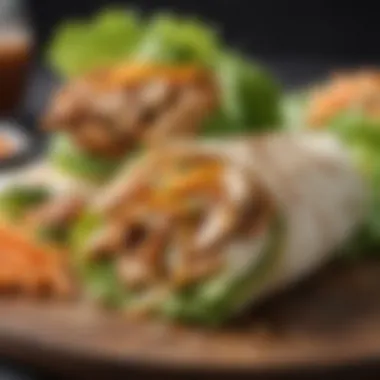Delicious Lunch Ideas for Your Keto Diet


Intro
The ketogenic diet has gained substantial attention in the nutritional landscape. It emphasizes a high-fat, low-carbohydrate intake, aiming to encourage the body to enter a state of ketosis. During ketosis, the body burns fat for energy instead of carbohydrates, leading to potential weight loss and other health benefits. For many, lunch can be a challenging meal to navigate, but with some foundational knowledge and creativity, it becomes straightforward to keep this meal both vibrant and aligned with keto principles.
For those embarking on or currently involved in the keto lifestyle, understanding essential ingredients is pivotal. Knowing which foods are beneficial allows individuals to create dishes that satisfy both taste buds and dietary needs. As we proceed, this article delves into diverse lunch suggestions, ingredient breakdowns, and preparation techniques tailored for individuals following a ketogenic regimen.
Ingredients Breakdown
Incorporating the right ingredients is crucial for supporting the ketogenic approach. Each component of a meal can greatly impact someone's ability to stick to the diet and enjoy their food.
Primary Ingredients
Focusing on high-fat, low-carb options, the following ingredients are instrumental:
- Avocados: Rich in healthy fats and essential micronutrients.
- Leafy Greens: Spinach, kale, and arugula provide vitamins without the carbs.
- Meats: Bacon, chicken, and beef not only supply necessary fat but also protein.
- Fish: Varieties like salmon and mackerel present healthy omega-3 options.
- Cheese: A flavorful addition that also contributes fat, found in types such as cheddar and mozzarella.
Optional Ingredients
Adding these elements can diversify meals:
- Nuts and Seeds: Almonds and chia seeds, bringing healthy crunch and oils.
- Coconut Oil: Enhances meals with added fat content.
- Low-Carb Vegetables: Ingredients like zucchini and cauliflower allow creativity with sides.
Essential Kitchen Tools
Having the right tools can streamline the meal prep process. Consider:
- Sharp Chef’s Knife: For efficient vegetable prep.
- Cutting Board: Anchors your prep space.
- High-Quality Blender: Smoothies or sauces made easier.
- Skillet: Suitable for various cooking techniques like sautéing and frying.
Step-by-Step Preparation
To navigate the Keto lunch arena effortlessly, mastering preparation methods is fundamental.
Prepping the Ingredients
- Begin by gathering and cleaning your ingredients.
- Chop vegetables and portion proteins according to desired servings.
- Measure out healthy fats, such as oils or butter, for cooking.
Cooking Techniques and Methods
Utilize various methods for a fulfilling meal:
- Sautéing: Excellent for quick cooking of vegetables and meats, maintaining flavor and texture.
- Grilling: Enhancing smoky notes in foods, particularly meats.
- Roasting: Good for developing deeper flavors in vegetables by carmelizing their sugars.
Assembly and Presentation Tips
- Arrange your plates with care.
- Balance colors and portions for visual appeal. Not too much on one side, but a uniform distribution will make the lunch appealing.
Dietary Considerations
A keto diet can accommodate diverse dietary needs.
Gluten-Free Options
Naturally, most keto foods are gluten-free, particularly those based on meats and vegetables.
Vegetarian and Vegan Substitutes
Looking for alternatives? Consider tempeh or Seitan as a protein-rich source; mix in nut butters to enhance flavor.
Nutrition Facts & Nutritional Considerations
Being aware of carbs is critical. Keeping total carb counts low while ensuring adequate micronutrient intake is the goal.


Variations and Customizations
Personalizing lunches enhances enjoyment of the meals.
Flavor Enhancements
Try adding herbs like basil or spices like paprika to elevate dishes.
Alternative Cooking Methods
Explore oven baking or slow cooking for different outcomes in your meals.
Pairing Suggestions (Sides, Drinks, etc.
)
Complement lunches with sides such as a fresh salad or drink options like herbal tea.
Common Commonly Asked Questionss and Troubleshooting
An array of queries arises when adopting a new diet approach.
Frequently Asked Questions
- Does keto work long-term? Research indicates that it can be effective for moderate fat reduction.
- Can I have dairy? Yes, prefer full-fat dairy, which aligns well with ketogenic principles.
Common Mistakes to Avoid
- Ignoring total calorie intake, which can occur even on keto.
- Over-relying on processed foods; whole foods are preferable.
Solutions to Potential Problems
Should energy levels drop, review meal composition to ensure adequate fat during lunches.
Maintaining a balanced intake of nutrients is crucial for sustaining energy levels and overall health on a keto diet.
As you create lunches that fit the principles of the ketogenic diet, experimentation pays off. Understand your palate while adhering to the dietary blueprint. With this approach, delicious, satisfying lunches are not only achievable but also enjoyable.
Understanding the Keto Diet
Understanding the ketogenic diet is crucial, especially when planning meals like lunch that align with its nutritional guidelines. The keto approach primarily focuses on low carbohydrate intake and higher consumption of fats. This dietary framework leads the body into ketosis, which significantly impacts energy levels and metabolic processes. Knowing the foundational aspects of the keto diet helps individuals make informed decisions about their meals.
What is the Ketogenic Diet?
The ketogenic diet is a high-fat, moderate-protein, and low-carbohydrate eating pattern. Generally, it restricts carbohydrates to about 20 to 50 grams per day. By limiting carbs, the body is forced to utilize fat as its primary energy source instead of glucose. This metabolic state, known as ketosis, promotes fat burning and can yield various health benefits. Many people choose the keto diet for weight loss, enhanced physical performance, or even managing certain medical conditions.
Key Principles of Keto Nutrition
Guiding one’s diet through keto requires understanding essential principles.
- Carbohydrate Limitation: Limiting carbohydrate intake sustains the state of ketosis. Individuals should focus on consuming non-starchy vegetables, some berries, and moderate amounts of dairy.
- Fat Emphasis: High consumption of healthy fats like avocados, nuts, seeds, and oils provides satiation without increasing carbohydrate intake.
- Protein Moderation: It's vital to maintain a moderate protein level. Overconsumption can kick the body out of ketosis, damaging the primary objectives.
These principles are essential in crafting balanced lunches that not only align with keto guidelines but also maintain flavor and satisfaction.
Benefits of Following Keto
Each dietary approach holds specific advantages. By following the keto diet, several benefits include:
- Weight Loss: The diet may assist in weight reduction through increased fat utilization.
- Reduced Hunger: Incorporating more fats often leads to increased feelings of fullness, easing the feeling of hunger during the day.
- Better Blood Sugar Control: This diet may stabilize blood sugars, offering potential benefits for individuals with insulin resistance or diabetes.
- Increased Energy Levels: Once in ketosis, many experience heightened stamina as fat is utilized efficiently.
Ultimately, comprehending the importance of the ketogenic diet sets the groundwork for experimenting with and enjoying various lunch ideas tailored for nutritional success.


Essential Ingredients for Keto Lunches
Understanding the essential ingredients for keto lunches is critical for anyone looking to maintain a ketogenic diet. These ingredients should support the overall principles of low carbohydrate intake, high fat consumption, and adequate protein levels. Incorporating these elements not only aids in successful meal preparation but also enhances the nutritional benefits of each lunch. By focusing on quality ingredients, individuals can ensure they create satisfying and healthful meals that align with their dietary goals. Below, we will explore the key components vital in this endeavor.
Low-Carb Vegetables
Low-carb vegetables are foundational to any keto meal. They add volume, color, and essential nutrients without excess carbohydrates. Vegetables such as spinach, kale, broccoli, and zucchini are excellent choices. They contribute vitamins, minerals, and antioxidants important for health.
When shopping, always look for produce that is vibrant and fresh. Keep in mind the recommended serving sizes to ensure you stay within your daily carb limit. Cooking methods should be simple; sautéing or steaming helps retain their nutritional value.
- Favorite Choices:
- Spinach
- Kale
- Broccoli
- Cauliflower
Quick and Easy Keto Lunch Ideas
Simplifying meal prep for the keto lifestyle is crucial for success. Quick and easy lunch ideas can help maintain high-energy levels while sticking to the low-carb principles of the diet. Many busy individuals often turn to convenience food, which can be detrimental to their dietary goals. Thus, planning a quick keto meal can avert dietary lapses.
Salads with a Protein Boost
Salads can serve as a great base for a keto-friendly meal. A typical salad can easily be enhanced using various protein sources which are key to a balanced diet. Consider adding grilled chicken breast, tender slices of steak, or even tuna for a filling option. Toppings such as avocados and hard-boiled eggs provide essential fats that align with keto principles.
In terms of creating keto-friendly salad dressings, incorporating olive oil, vinegar, and mustard can elevate flavor without the addition of sugars. Pairing these electrolytes with crunchy low-carb vegetables, such as zucchini or radishes, adds texture.
A few ideas for protein-packed salads can include:
- Caesar salad with chicken and a low-carb dressing
- Spinach and bacon with a warm vinaigrette
- Greek salad with feta, olives, and grilled shrimp
Keto Wraps and Lettuce Sandwiches
Wraps have long been a staple in traditional lunches, but a keto rendition offers significant benefits. 🌯 The key here is to use lettuce leaves in place of bread. Health-conscious individuals can utilize romaine, iceberg, or collard greens for wrapping.
Fill these with a variety of delicious ingredients. Options might include sliced turkey, cream cheese, and roasted bell peppers. These variations keep meals both low in carbs and flavorful.
To enhance wraps further, good condiments are essential. Mustard or avocado works well, adding liquid fat without extra carbohydrates. This not only augments flavor but can also be quite satisfying.
Low-Carb Bowls
Low-carb bowls provide immense flexibility. They allow the stacking of favorite ingredients into one hearty meal. Building a perfect low-carb bowl involves a composite of fat, protein, and a bit of low-carb veg.
First, start with a base such as cauliflower rice. This serves as a solid, low-carb foundation. Then, include protein such as cooked chicken or scrambled eggs. Lastly, finish it with an array of healthy fats like cheese or guacamole.
Some popular variations include:
- Taco bowls using seasoned ground beef topped with cheese and sour cream
- Breakfast bowls loaded with eggs, avocado, and cheese
- Stir-fry bases with low-carb vegetables and shrimp
These quick and easy meal ideas serve not just to satiate hunger, but to support daily nutritional needs.
These suggestions facilitate enjoyable adherence to the keto eating style, making every meal an opportunity for both nutrition and taste while producing manageable options for a hectic lifestyle.
Creative Meal Prepping for Keto Lunches
Creative meal prep is pivotal for those adhering to a ketogenic diet. It makes sticking to the diet easier while saving some fundamental time during busy weekdays. Using proper techniques in meal prepping allows for the pre-calculation of nutrient values, ensuring every lunch aligns with keto goals. These strategies provide a planning structure that can lessen impulsive food choices, minimizing the likelihood of veering off the keto path. In addition, advance preparation means enjoying satisfying, home-cooked meals rather than opting for unhealthy convenient food when hunger strikes.
Batch Cooking Strategies
Batch cooking refers to the process of preparing large quantities of food at once to be consumed later. This simplifies meal times considerably. It's a smart choice for busy individuals. When preparing for keto lunches, focus on versatile ingredients. Cook proteins like chicken or beef in bulk. Roasting low-carb vegetables such as zucchini and bell peppers can also form nutritious bases for multiple dishes. It is best to portion appropriate servings in advance, allowing for a quick reach when hunger arises. Here are some useful tips for effective batch cooking:
- Select a day for meal prep, typically weekends, to maximize time.
- Invest in quality food storage containers, preferably glass for safety and durability.
- Choose recipes that allow for easy reheating without compromising texture and flavor.
- Consider making large batches of soups or casseroles; they freeze well and taste great after reheating.
Storing and Reheating Tips


Storage and reheating are joint components of effective meal prep. After batch cooking, utilize different methods for preserving freshness:
- Cool food completely before transferring to container. This reduces condensation buildup.
- Label and date each container. It helps to know what is available and how fresh it is.
- Storing items like shredded chicken or cooked vegetables in separate containers can help in creating quick lunches.
When it comes time to reheat, the method used can affect the quality of your meal:
- Microwave may be the fastest option but can lead to rubbery textures. Use it with caution for proteins.
- Stovetop or oven reheating usually yield better results, preserving flavor and consistency. On average, a target temperature of 165°F is ideal to ensure food is completely heated.
Meal prepping is not just about creating food; it's about ensuring easy access to healthful options. This important practice empowers disciplined eating habits while relishing gourmet-style meals at home.
By investing time in batch cooking and careful storage, meal prep becomes less of a chore and more of an aligned habit in sustaining a keto lifestyle. This approach opens the door to creative experimentation with recipes and flavors while maintaining simplicity—remarkable for anyone, but particularly those dedicated to the ketogenic path.
Specialty Keto Lunch Ideas
The Speciality Keto Lunch Ideas section is dedicated to offering innovative and wholesome alternatives for those who follow a ketogenic diet. It is easy to fall into a routine with meals, but exploring specialty options allows individuals to not only adhere to their dietary regimen but also discover new flavors and textures. Incorporating different meal ideas can keep the diet engaging. Ultimately, this leads to longer-term success.
Keto-Friendly Soups and Stews
Keto-friendly soups and stews can transform the notion of meal prep. They are nourishing and can be quite simple to make. The key consideration with these dishes is to utilize high-fat ingredients while avoiding starchy items such as potatoes or cornstarch that typically thicken broths.
When crafting a keto-friendly soup, selecting the right base is essential. Bone broth, for instance, is nutritious and provides a base that is rich in fat. You can also explore various vegetables, like zucchini and cauliflower, which add bulk without the carbs.
A few composition ideas include:
- Creamy Mushroom Soup: Using heavy cream, mushrooms, and garlic. Innovation can come from adding various spices or herbs.
- Spicy Chicken Stew: Incorporating shredded chicken, bell peppers, and spices like cumin can create a hearty meal. The protein and fat sources sustain energy levels throughout the day.
Addressing Common Challenges
Understanding and mitigating challenges is critical when adopting a ketogenic diet. Many individuals encounter obstacles that may derail their progress or obscure the potential benefits of this dietary approach. It is not only about what food choices are made but also about how one navigates daily life filled with social interactions, cravings, and diverse food environments. Here, we delve into some common challenges faced by keto dieters, specifically focusing on dining out and managing cravings.
Eating Out on a Keto Diet
Eating out presents a hurdle for those following a keto diet, yet it is manageable with the right strategies. One key aspect is selecting restaurants that clearly distinguish between keto-friendly options. It's vital to scrutinize menus on websites beforehand, if available. Additionally, many establishments offer customization for meals. For instance, opting for a burger without the bun, or ensuring that vegetables are low-carb choices, can maintain one’s diet while enjoying dining out.
Some practical strategies when eating out include:
- Always ask for dressings and sauces on the side to control one's intake.
- Prioritize protein sources like grilled chicken, steak, or fish, which typically align well with keto requirements.
- Inquire about ingredients in certain dishes, as hidden sugars in dressings or sides can pose a challenge.
"Awareness and preparation ahead of time is the cornerstone of dining out successfully on a keto diet."
Patience also plays a crucial role; one may not find perfect meal options every time. Instead, focusing on modifying specific dishes or choosing simpler fare can be a sensible approach. If unsure about a place, starting with smaller cafes and local kitchens known for customization might be favorable.
Dealing with Cravings
Cravings are a universal part of any dietary regime, more so for those embracing the keto journey. When transitioning into a low-carb lifestyle, the body can signal a need for carbohydrates. This can manifest as cravings for sweet or starchy foods. Facing these cravings requires not only willpower but also effective techniques to manage and mitigate them.
Here are methods to help combat cravings effectively:
- Have keto snacks readily available, such as cheese, nuts or homemade fat bombs, to quell hunger between meals.
- Staying hydrated is essential. Oftentimes, thirst can be mistaken for cravings, thereby keeping fluids available can reduce unnecessary snacking.
- Engage in distractions, whether it's a short walk, reading a book, or tackling a hobby. Redirecting focus helps avoid impulsivity sustained by temptation.
Coping with cravings might require minor modification to meal plans. Integrating small indulgences, like dark chocolate in moderation or a dessert that fits within keto parameters, might be beneficial. Ultimately, acknowledging cravings as fleeting feelings allows dieters to strategize appropriately without compromising their diet.
Maintaining a well, thought-out framework when addressing these challenges can cultivate resilience. Adapting approaches over time remains significant on this health journey.
Closure
The conclusion serves as a crucial component of this article, tying together the various themes related to lunch ideas on the ketogenic diet. It emphasizes the significance of adapting keto meals without sacrificing flavor or satisfaction. As individuals seek a balanced approach to healthy eating, sustainable practices around food choices are essential, especially for maintaining a keto lifestyle.
Sustaining a Keto Lifestyle
Adhering to a keto diet is not merely about restricting carbohydrates. It involves understanding and embracing changes that foundationally transform your relationship with food. The keto lifestyle can be sustainable when individuals find adaptable delicious, and practical lunch options.
- Variety: Incorporating different ingredients keeps lunches engaging. Rotate between diverse proteins like chicken, beef, or fatty fish. This prevents boredom and ensures a wide range of nutrients.
- Meal Prep: Plan and prepare meals ahead. Create a structured schedule for batch cooking during weekends. Doing so minimizes stress during busy weekdays while providing the setup for nutritious meals.
- Listen to Your Body: Recognize your hunger signals. It helps in making smarter choices regarding portion sizes. If feeling fuller, don't push to eat more; trust your sense of fullness.
- Focus on Whole Foods: Emphasize mainly whole, unprocessed foods. They generally fit into the keto framework well, avoiding unnecessary sugars and additives.
- Experiment: Pay attention to your tastes while trying new flavors or cooking styles. Try adding herbs and seasonings to personalize your meals, which can enliven standard fare.
To maintain momentum and make a lasting change, continual learning and adapting are needed. Ensuring protein-rich lunches and incorporating healthy fats frequently through lovingly prepared meals can solidify this journey.
"Consistency is key. Success lies in your palate’s adjustment and the flexibility of choices.”
Creating keto lunches that you enjoy is crucial. Doing so fosters a positive association with your eating habits, raising your adherence to the diet. A blend of creativity and structure ensures a fulfilling experience, extending beyond mere weight reduction, offering a potential path toward overall lifestyle change.







